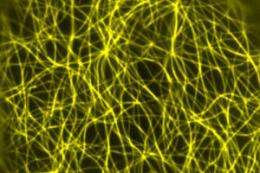Scientists discover important mechanism in plant cells which regulates direction that plant cells grow

Scientists have discovered an important mechanism in plant cells which regulates the direction that plant cells grow.
The discovery could have the potential to develop higher yielding crops or increase the size of plants grown for use in biofuels.
A BBSRC-funded team at The University of Manchester demonstrated how the building of plant cell scaffolds is regulated to produce distinct shapes, allowing the plant cell to grow in particular directions.
Plant cells can expand to up to 1,000 times their original size, and the growth and shape of plant cells is determined by the direction of expansion.
Many plant cells, such as those in the root or stem, need to expand in a particular direction for the plant to develop properly.
Key to this process is the distribution of cellulose, a strong compound which forms much of the plant cell wall.
A protein scaffold with the cell, called the microtubule network, dictates the organisation of cellulose in the wall by forming tracks which guide its placement.
Previous work found that microtubules are organised into aligned configurations, with poorly aligned microtubules being cut away by an enzyme called katanin.
The researchers demonstrated that a protein called SPIRAL2 regulates where and when microtubule cutting occurs. Depending on the organisation of microtubule required by the plant SPR2 either remains stationary preventing katanin cutting the microtubules or is constantly moving along microtubules exposing areas for katanin to sever microtubules and drive the formation of aligned microtubules.
It is the first plant protein described that determine microtubule organisation by regulating where and when katanin cuts microtubules.
Professor Simon Turner, who led the research in the Faculty of Life Sciences, said: "This study answers some important fundamental questions about cell growth and microtubule patterning, and potentially gives us the ability to predictably alter microtubule patterns.
"In the future this may allow us to manipulate plant development and engineer more efficient canopies or stronger shorter stems. It may also provide a means of increasing plant biomass either for better crop yields or to generate material for bioenergy production."
The paper, 'SPIRAL2 Determines Plant Microtubule Organization by Modulating Microtubule Severing,' is published in Current Biology.
Journal information: Current Biology
Provided by University of Manchester

















